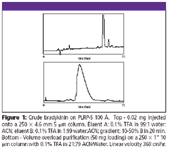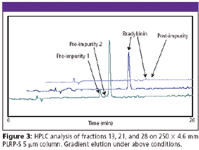HPLC Analysis and Preparative Scale Purification of Synthetic Bradykinin
The Application Notebook
Bradykinin, a 9 amino acid peptide, is a physiologically and pharmacologically active peptide of the kinin group of proteins, which is used in the development of antagonists and therapies for hereditary angioedema. In this application, 50 mg of crude bradykinin, synthesised on a StratoSpheresâ„¢ PL-Rink resin, is purified using an HPLC method that can be scaled from the laboratory through to full production.
Bradykinin, a 9 amino acid peptide, is a physiologically and pharmacologically active peptide of the kinin group of proteins, which is used in the development of antagonists and therapies for hereditary angioedema. In this application, 50 mg of crude bradykinin, synthesised on a StratoSpheres™ PL-Rink resin, is purified using an HPLC method that can be scaled from the laboratory through to full production.
Experimental
Initially, screening of the crude bradykinin was carried out using a high performance PLRP-S 100Å 5 μm 250 × 4.6 mm column and resolution optimized using a linear gradient, see Figure 1. As a result, isocratic elution conditions of 0.1% TFA in 21:79 MeCN/Water were chosen for the preparative purification stage.

Figure 1
Figure 1 also shows the results of a volume overload purification of crude bradykinin in conjunction with a step gradient. A dilute solution containing 50 mg of crude peptide was loaded onto a 250 × 1" (27mm i.d.) Load&Lock™ (L&L) column, packed with 100Å 10 μm PLRP-S, at low ACN content, followed by a step gradient to the isocratic elution conditions of 21% MeCN to give the separation.

Figure 2
Results
Fractions of bradykinin were collected on a time basis throughout the elution (see Figure 2), and subsequent HPLC analysis revealed that 100% purity can be achieved with a 77% recovery (purity of the crude was 84.6%). For a 100% recovery of bradykinin the purity went down to 77%. Figure 3 shows the HPLC chromatograms of three of the fractions when run under initial scouting gradient conditions.

Figure 3
Conclusion
Bradykinin can be successfully purified on a 1" i.d. Load & Lock column packed with 10 μm PLRP-S material, following initial screening on a smaller particle size version of the media. Volume overload with a step gradient followed by isocratic elution allows large quantities of the peptide to be isolated with excellent purity and recovery.

Varian, Inc.
25200 Commercentre Drive, Lake Forest, CA 92630-8810
Tel: 949-770-9381, Fax: 949-770-0863

Pick Your Poison. Isolation of Paclitaxel (Mar 2025)
March 7th 2025The diterpenoid, paclitaxel, which was identified as a potent chemotherapy agent for breast and ovarian cancer originates from the Pacific Yew tree. The isolation of paclitaxel from its major impurities is shown with the use of Hamilton’s PRP-1 (5 µm) HPLC column.

.png&w=3840&q=75)

.png&w=3840&q=75)



.png&w=3840&q=75)



.png&w=3840&q=75)













